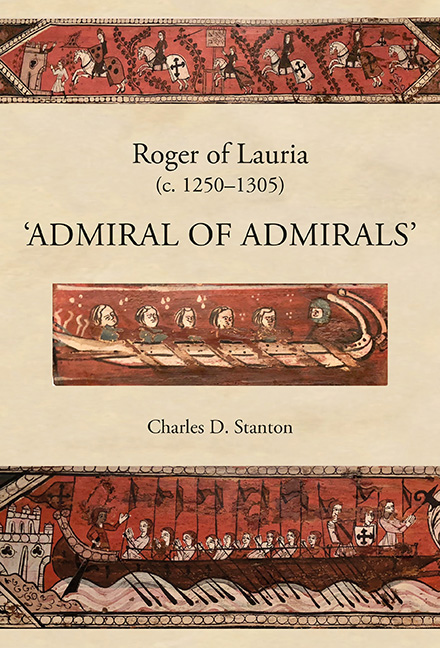Book contents
- Frontmatter
- Dedication
- Contents
- List of Illustrations
- Prologue
- 1 Battle of Benevento (26 February 1266)
- 2 A Calabrian Exile in the Court of Aragon (1262–1282)
- 3 Battle of Tagliacozzo (23 August 1268)
- 4 Aragonese Expansion (1229–1282)
- 5 Angevin Consolidation and Aggrandizement (1268–1282)
- 6 Revolt of the Vespers (30 March 1282)
- 7 Aragonese Intervention (August–October 1282)
- 8 Stalemate (November 1282–March 1283)
- 9 Admiral of Aragon (20 April 1283)
- 10 The Opposing Fleets (1282–1302)
- 11 Battle of Malta (8 June 1283)
- 12 Anjou's Dreams of Empire Dashed (June–November 1284)
- 13 France's Crusade Against Aragon (May–November 1285)
- 14 Battle of the Counts (23 June 1287)
- 15 Truces and Treaties (June 1287–November 1291)
- 16 Raid on Romania (Summer 1292)
- 17 Switching Sides (December 1293–April 1297)
- 18 Aragon's Invasion of Sicily at Anjou's Bidding (1298/1299)
- 19 Lauria's Last Great Campaign (Summer 1299–Spring 1300)
- 20 Endgame (Spring 1301–Summer 1302)
- Epilogue
- Bibliography
- Index
5 - Angevin Consolidation and Aggrandizement (1268–1282)
Published online by Cambridge University Press: 24 October 2019
- Frontmatter
- Dedication
- Contents
- List of Illustrations
- Prologue
- 1 Battle of Benevento (26 February 1266)
- 2 A Calabrian Exile in the Court of Aragon (1262–1282)
- 3 Battle of Tagliacozzo (23 August 1268)
- 4 Aragonese Expansion (1229–1282)
- 5 Angevin Consolidation and Aggrandizement (1268–1282)
- 6 Revolt of the Vespers (30 March 1282)
- 7 Aragonese Intervention (August–October 1282)
- 8 Stalemate (November 1282–March 1283)
- 9 Admiral of Aragon (20 April 1283)
- 10 The Opposing Fleets (1282–1302)
- 11 Battle of Malta (8 June 1283)
- 12 Anjou's Dreams of Empire Dashed (June–November 1284)
- 13 France's Crusade Against Aragon (May–November 1285)
- 14 Battle of the Counts (23 June 1287)
- 15 Truces and Treaties (June 1287–November 1291)
- 16 Raid on Romania (Summer 1292)
- 17 Switching Sides (December 1293–April 1297)
- 18 Aragon's Invasion of Sicily at Anjou's Bidding (1298/1299)
- 19 Lauria's Last Great Campaign (Summer 1299–Spring 1300)
- 20 Endgame (Spring 1301–Summer 1302)
- Epilogue
- Bibliography
- Index
Summary
FOLLOWING THE BATTLE OF TAGLIACOZZO, Charles of Anjou had wasted no time asserting his authority over north and central Italy while consolidating his control of the Kingdom of Sicily (Map 4). The clemency he had employed in the aftermath of the Battle of Benevento as a means of winning over dissidents had been discarded. He now ridded himself of rivals with a combination of ruthless retribution and relentless repression. He began by opportunistically seizing several key administrative positions. On 12 September 1268, barely three weeks after his victory at Tagliacozzo, Charles wrote to his brother King Louis IX to inform him that the citizens of Rome had chosen him senator for life by ‘unanimous’ acclamation. And Pope Clement IV, sometime prior to his death at Viterbo on 29 November, had named Charles as Imperial Vicar for Tuscany. Furthermore, temporary leadership vacuums in both the papal curia and the court of the Holy Roman Empire meant that Anjou held in his hands undisputed power on the peninsula.
Charles exploited these newly acquired appointments with dispatch. By the end of September, he was in Rome installing an Angevin autocracy that controlled virtually all aspects of the city's administration. He used his imperial vicariate to eliminate opposition in Tuscany by appointing Jean Bitaud as his representative in the region. The latter led the Florentine Guelphs to victory over the Sienese at Colle di Val d'Elsa on 17 June 1269, prompting Siena's submission in August of the following year. An alliance with jealous Genoa had isolated Pisa and forced it to plead for peace in the spring of 1270. As for northern Italy, most of the Piedmont willingly submitted to him, but Lombardy remained resistant – particularly the Ghibelline cities of Pavia and Verona. That said, while the majority of Lombardy's lords and municipalities opposed Angevin domination, they were at least solidly Guelph. Charles contented himself with assigning a seneschal to represent his interests in the province.
ANGEVIN REPRESSION
Anjou was far more proactive with regard to the Regno. Remnants of the Swabian rebels had sought safe haven with the Saracens of Lucera who were still in revolt. Charles himself laid siege to the city in April 1269, and by 28 August he had finally starved it into submission. The Muslim inhabitants were shown mercy but dispersed throughout the Regno. The Christian rebels, tellingly, were all summarily executed.
- Type
- Chapter
- Information
- Roger of Lauria (c.1250–1305)‘Admiral of Admirals’, pp. 66 - 78Publisher: Boydell & BrewerPrint publication year: 2019

